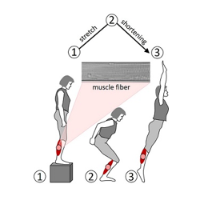Stretch-shortening cycles (SSC) represent the typical form of muscular loading during terrestrial locomotion (e.g. running, walking, jumping). During the concentric phase of stretch-shortening cycles, muscle strength, work and performance are increased by up to 50% compared to purely concentric muscle actions, which contributes to high locomotion speeds and allows for high movement economy and efficiency. The increase in performance is caused by an interaction of different mechanisms, including muscular pre-activation, the stretch reflex, and the storage and recovery of energy in elastic tissues. A significant contribution probably comes from the muscle cell itself. However, the mechanisms of performance enhancement in the SSC at the muscle cell level are not yet well understood.
In a project funded by the German Research Foundation (DFG), the team around Prof. Siebert, associate member of the Cluster of Excellence SimTech from the Institute for Sports and Movement Science at the University of Stuttgart, in cooperation with Prof. Hahn (University of Bochum) and Prof. Seiberl (TU Munich), has now been able to clarify the contributions of active and passive muscle cell structures to performance enhancement at the SSC. For this purpose, Dr. André Tomalka conducted stretch-shortening experiments with skinned muscle fibers. By using a crossbridge inhibitor (Blebbistatin), active crossbridge contributions could be isolated from passive non-crossbridge contributions.
The experiments yielded the following main results: The forces and work are significantly increased during the concentric phase of the SSC compared to purely concentric contractions. Non-cross-bridge structures are significantly involved in the performance increase in the SSC, most likely due to an interaction of actin and titin. The cross-bridge activity is - at least partially - necessary for performance enhancement in the SSC, as it enables the titin-actin interaction.
The results of this study contribute to a detailed understanding of the SSC at the cellular level. On the one hand, this is important for a deeper understanding of the efficiency of human locomotion. On the other hand, the findings can be used for the development of efficient humanoid drives with applications in robotics, prosthetics and medical technology.


